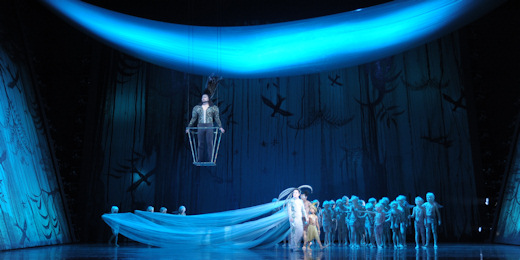Other Links
Editorial Board
- UK Editors
- Roger Jones and John Quinn
Editors for The Americas - Bruce Hodges and Jonathan Spencer Jones
European Editors - Bettina Mara and Jens F Laurson
Consulting Editor - Bill Kenny
Assistant Webmaster -Stan Metzger
Founder - Len Mullenger
Google Site Search
SEEN AND HEARD INTERNATIONAL OPERA REVIEW
Britten, A Midsummer Night’s Dream: Soloists, Chorus and Orchestra of Lyric Opera of Chicago, Rory MacDonald (conductor), Anima Young Singers of Greater Chicago, Civic Opera House, Chicago, 13.11.2010 (JLZ)
Set Designer: Dale FergusonCostume Designer: Dale Ferguson
Lighting Designer: Damien Cooper
Director: Neil Armfield
Choreographer: Denni Sayers
Children’s Chorus Master: Emily Ellsworth
Conductor: Rory MacDonald
Cast:
Oberon: David Daniels
Tytania: Anna ChristyBottom: Peter Rose
Helena: Erin Wall
Hermia: Elizabeth DeShong
Lysander: Shawn Mathey
Demetrius: Lucas Meachem
Flute: Keith Jameson
Peter Quince: Sam Handley
Hippolyta: Kelley O'Connor
Theseus: Craig Irvin
Snout: James Kryshak
Snug: Wilbur Pauley
Puck: Esteban Andres Cruz
Starveling: Paul Scholten
Production Picture © Dan Rest
Lyric Opera of Chicago’s new production of A Midsummer Night’s Dream—the second Shakespeare opera of the current season—offers an outstanding interpretation of this important work by Benjamin Britten. The attractive staging is the springboard for a uniformly excellent cast, coupled with faithfulness to the Shakespeare’s spirit in Britten’s persuasive score. And while some might be deterred by a twentieth-century opera, this audience responded to the performance enthusiastically.
At the center of the story are the characters Tytania and Oberon, the queen and king of the fairy kingdom, and as the former, Anna Christy was vocally stunning. Her register, particularly the uppermost tessitura, is rich, full, and clear. Christy’s technique is solid, with precise pitch, rhythmic accuracy, clear articulation and a fine sense of line. Perhaps most important, Christy worked well with David Daniels, her fairy counterpart, both in creating the dramatic tension that sets off the events at the beginning, and in representing the renewed warmth and amity at the work’s conclusion.
As Oberon, David Daniels gave an equally estimable performance, with ringing pitches, rhythmic precision, and commanding stage presence. For the first two acts, Daniels was suspended over the stage, and even within the confined space of a “movable basket,” the gestures, glances, and intonations from Daniels created a three-dimensional portrayal. Indeed, observing his interactions with Christy and Esteban Andres Cruz (as Puck), Daniels was the dramatic and musical core of this production.
A seasoned actor, Cruz conveyed Puck’s physicality and warmth, and offered a foil to the singers with his articulate, nuanced dialogue and fluid movements. In a role that moves the libretto forward dramatically, Cruz’s dynamic presence contributed substantially to this production’s success.
As the mortal couples, Erin Wall (Helena), Elizabeth DeShong (Hermia), Shawn Mathey (Lysander), and Lucas Meachem (Demetrius) formed a solid unit, filled with the plot’s mistaken emotions. From the men emerged audible reactions to the various magic spells, and the frustrated passions of the women culminated in the duet between Wall and DeShong in the second act’s climax.
Equally strong were the rustics, particularly Peter Rose, who was a delightful and engaging Bottom—appealing both musically and dramatically. His even baritone was richly textured, and when transformed into an ass (to the chagrin of the fellow rustics and the spell-induced delight of Tytania), he seemed totally at ease, dramatically. The braying gestures were present without exaggeration, and in the “play within the opera,” the hyperbolic caricature of the country Pyramus was suitably over the top. Rose and the other rustics worked well together rendering their characters, and the Anima Children’s Chorus brought an army of fairies to the stage.
Shared with Houston Grand Opera and the Canadian Opera Company, the production was elegant in its minimal design and offered impressive opportunities for lighting, blocking, and timing to create the effect of a much more elaborate Athenian world. The immense fabric canopy above the stage gave shape, a simple device, yet subtly complex in the ways in which it shifted by being waved, dropped or lifted. Plus, the fabric’s blue hue took on various shadings, depending on the light, and also served as another prop when dropped to the floor. The conductor Rory MacDonald brought out the nuances of the score, with his sense of dynamics, phrasing, and tempo giving Britten’s masterpiece the sense of shape and structure the composer intended. At the end, the success of MacDonald’s efforts was evident in the strong response of an attentive and appreciative audience.
James L. Zychowicz

